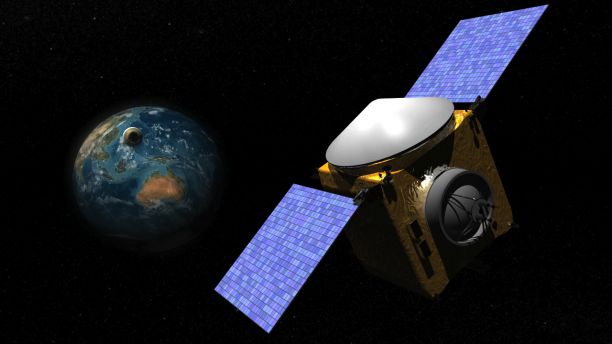May 16, 2013
By Daniel Stolte
OSIRIS-REx, the $1 billion asteroid sample return mission led by the University of Arizona, reached a major milestone on May 16: The project passed the agency-level confirmation review called Key Decision Point-C, or KDP-C. KDP-C authorized continuation of the project into the next phase of development, giving the team the authority to proceed toward launch in 2016.
"This means we have now made the final deal with NASA in terms of the mission objective, the cost cap and the schedule all the way from development and launch through Earth return," said Dante Lauretta, UA planetary science professor and the mission's principal investigator.
"We have presented our plan, including all aspects of the mission, from the engineering to the science to the schedule, and NASA has accepted that plan and committed to fully fund the mission."
The UA is leading the mission. For the first time in space-exploration history, the mission will travel to and return pristine samples of a carbonaceous asteroid with known geologic context. Such samples are critical to understanding the origin of the solar system, Earth and life, Lauretta explained.
"Successfully passing KDP-C is a major milestone for the project," said Mike Donnelly, OSIRIS-REx project manager for NASA's Goddard Space Flight Center in Greenbelt, Md. "This means that the agency believes we have an executable plan to return a sample from the asteroid, Bennu. It now falls upon the project and its development team members to execute that plan."
The OSIRIS-REx mission will travel to near-Earth asteroid Bennu (named via a recent student competion), study it for a year with a variety of instruments, collect a sample and return it to Earth in 2023.
Measuring more than 1,600 feet in diameter, the OSIRIS-REx target asteroid is uniquely interesting scientifically, while at the same time one of the most potentially hazardous objects known, with a one-in-2,000 chance of colliding with Earth in the late 22nd century. The asteroid could hold clues to the origin of the solar system.
So-called primitive carbonaceous chondrites are very special to scientists studying the origins of our solar system because they represent time capsules from the very beginning of the solar system 4.5 billion years ago. They are believed to hold primordial building blocks of organic material that potentially could have provided the very basic ingredients for life on Earth.
OSIRIS-REx will map the asteroid's global properties, measure non-gravitational forces and provide observations that can be compared with data obtained by telescope observations from Earth. OSIRIS-REx will collect at least 60 grams (about 2 ounces) of surface material. The spacecraft will return samples to Earth for scientists to study for decades.
The return to Earth of pristine samples with known geologic context will enable precise analyses that cannot be duplicated by spacecraft-based instruments. Pristine carbonaceous materials obtained directly from an asteroid surface have never before been analyzed in laboratories on Earth.
The mission's cost breaks down roughly into $800 million for the flight system and science operations and $240 million for the launch rocket. Science operations will be performed on the UA campus; University scientists and engineers will build the camera suite for the spacecraft.
On OSIRIS-REx, the UA is partnering with the NASA Goddard Space Flight Center, which will manage the mission, and Lockheed Martin Space Systems in Littleton, Colo., which will build and operate the spacecraft.
Through extensive study of meteorites, which are essentially fragments of asteroids that fell to the Earth's surface, UA scientists have been able to formulate leading theories of asteroid formation, composition and their role in answering the important questions of the source of water and organics that may have seeded life on Earth.
"The entire OSIRIS-REx team has worked very hard to get to this point. We have a long way to go before we arrive at Bennu in 2018, but I have every confidence that when we do, we will have built a supremely capable system to return a sample of this primitive asteroid," Lauretta said.
Lauretta said obtaining NASA's final approval was a great achievement in continuing the vision and legacy of Michael Drake, former director of the UA's Lunar and Planetary Lab who died in September 2011.
"He would be very proud and happy about this milestone," Lauretta said. "He was my friend and mentor and worked tirelessly until the very last day on seeing this mission become a reality."
All mission science operations will be performed on the UA campus. OSIRIS-REx will provide a significant boost to the Arizona economy; approximately $200 million will be spent in Tucson and across Arizona.















